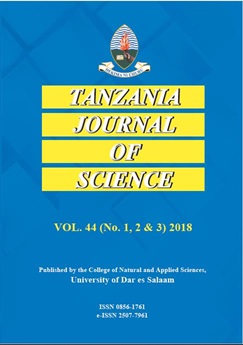Chemical Composition and Bioactive Potential of Extracts from Diospyros capricornuta F. White against Aspergillus flavus and Aspergillus parasiticus
DOI:
https://doi.org/10.4314/tjs.v48i3.9Abstract
Diospyros capricornuta is an endemic species widely distributed along the coast of Tanzania that is used as food condiments and traditional medicine. The chemical compositions of Diospyros capricornuta leaves, stem-bark, and root-bark extracts; and their bioactive potentials against Aspergillus flavus and Aspergillus parasiticus were investigated. The leaves, stem-bark, and root-bark samples of D. capricornuta were extracted using Soxhlet apparatus and the resultant extracts were analyzed using Gas Chromatography-Mass Spectrometry (GC-MS). A total of 14 compounds were identified from the extracts, whereby 2,4-di-tert-butylphenol was the most abundant compound in all extracts. The growth and aflatoxin production inhibitions against A. flavus and A. parasiticus were determined via antifungal and antiaflatoxigenic bioassays of the extracts at the concentrations of 0.0, 62.5, 125.0, and 250.0 µg/mL using a poisoned-food method. The High-Performance Liquid Chromatography (HPLC) technique was used to quantify the aflatoxins after bioassays to evaluate aflatoxin inhibitions. The stem-bark extracts at the highest dose of 250.0 µg/mL inhibited aflatoxin production by A. flavus for over 99% and A. parasiticus for over 94%. Overall, the results show that the leaves, stem-bark, and root-bark extracts of D. capricornuta are potential inhibitors against A. flavus and A. parasiticus-the producers of aflatoxins.
Keywords: Diospyros capricornuta, Growth inhibitions, Aflatoxin inhibitions, Aspergillus flavus, and Aspergillus parasiticus

